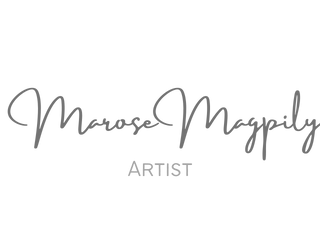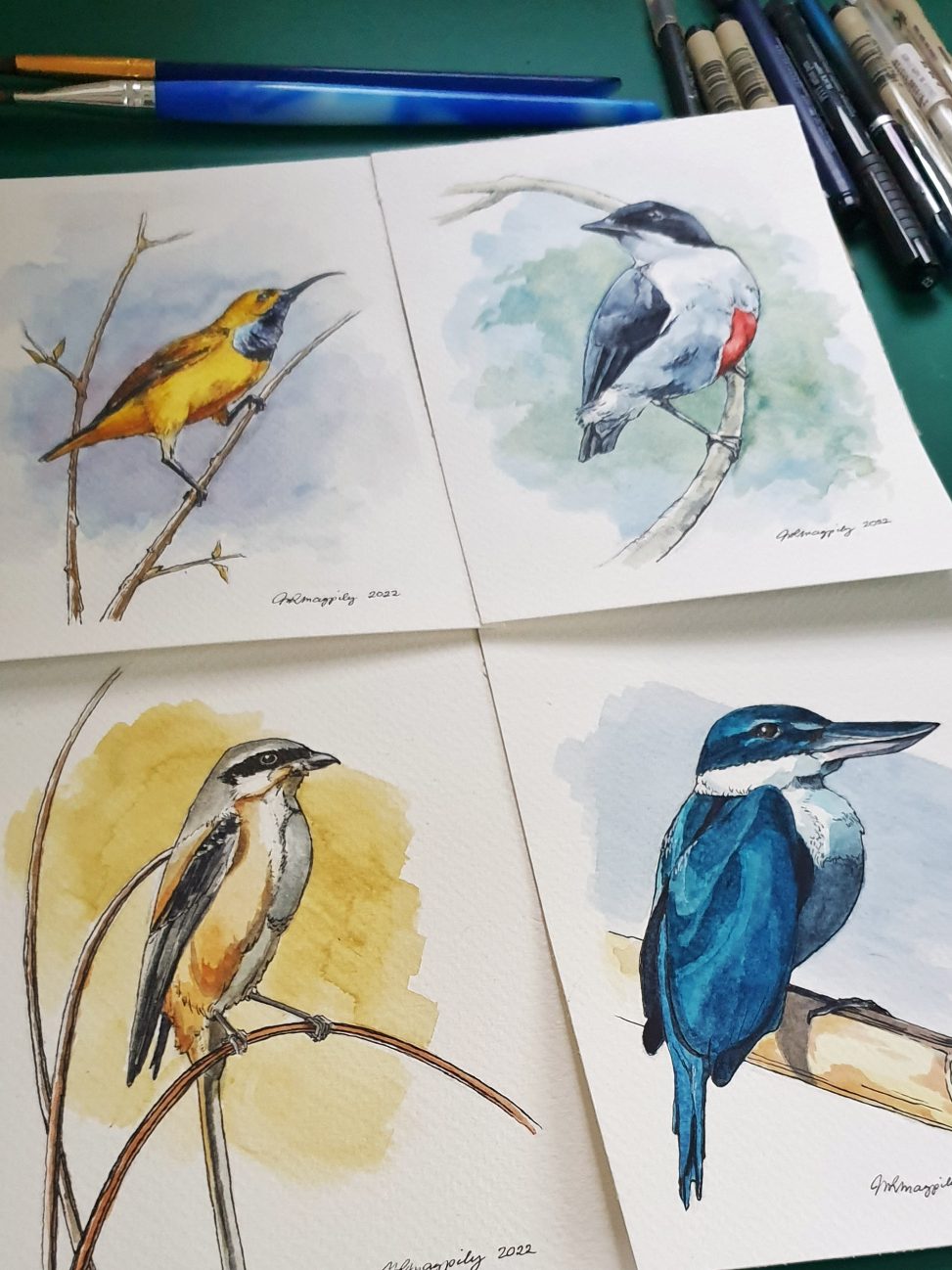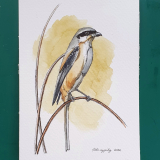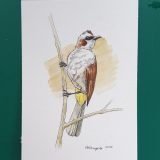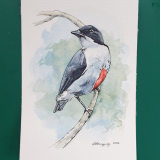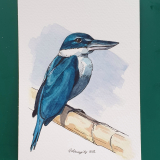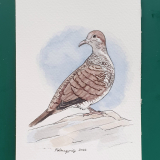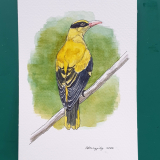These days, one of my favorite things to do when walking around our neighborhood is to spot different wild birds. I also attempt to photograph them with my camera phone, but, as you can imagine, taking a decent photo of a bird at a distance with such limited equipment is quite challenging. So to make up for my poor photography, I decided to draw and paint the birds in order to create some kind of documentation of the ones I’ve seen to date.
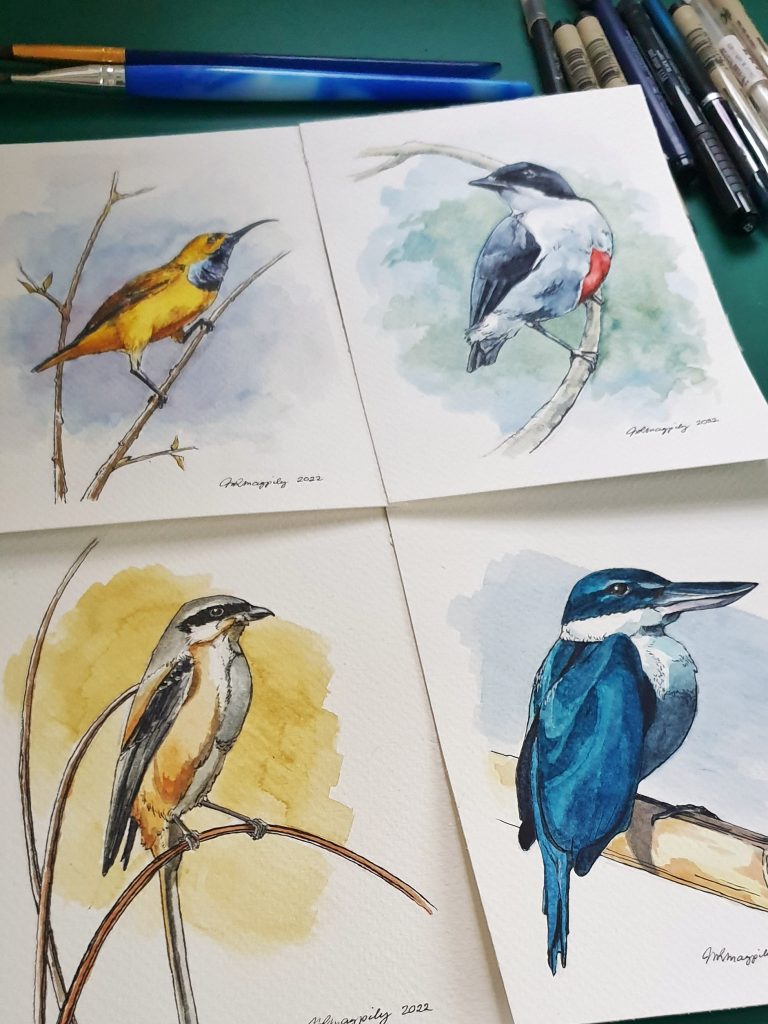
I’ve managed only seven for now, but I will continue to grow this collection as I gather more reference photos for the birds that I’ve seen. My list of birds so far (at least the ones I remember) includes the following:
- Brown Shrike **
- Black-naped Oriole **
- Olive-backed Sunbird **
- Zebra Dove **
- Collared Kingfisher **
- Red-keeled Flowerpecker **
- Yellow-vented Bulbul **
- Philippine Pied Fantail *
- Chestnut Munia *
- Large-billed Crow *
- Crested Myna *
- Eurasian Tree Sparrow *
- Night Heron *
- Little Egret *
- Barred Rail *
- Philippine Pygmy Woodpecker *
- White-breasted Wood Swallow *
- Pacific Swallow *
- Blue Rock Thrush *
- Spotted Dove
- Colasisi / Philippine Hanging Parrot
- Rose-ringed Parakeet
* photographed **photographed and illustrated
I do believe this is the first time I ever bothered to make a list of the birds I’ve seen, and it surprised me to discover that my list is up to 20. I’d say that’s not too bad for being barely a hobbyist birdwatcher.
And here’s a look at the birds I’ve illustrated so far:
As for the materials that I used to do the ink and wash illustrations, they are the following:
- Durer 300 GSM Watercolor Paper 5″x7″ Block – Cold-pressed
- Pencil (HB, H, 2H or harder)
- Eraser
- Sakura Pigma Micron Pens (005, 01, 02, 03)
- Yarka Watercolor Paint (or any artist grade paint)
The process is pretty simple:
First, I found a good reference photo of the bird I wanted to paint. Then I cropped the image to fit within the 5×7 watercolor paper. If I needed to fine tune the image, I used either Snapseed on my phone or Photoshop on my laptop to edit and enhance parts of the photo.
Next, I sketched the bird onto the paper using a pencil. I made sure to keep my pencil sketching light so it could easily be erased.
Then I went over the pencil sketch with the 005 Pigma Micron Pen, while still checking the reference photo for any details that I might have missed.
I didn’t bother drawing in every little detail such as all the tiny feathers, mostly I drew in indications of these. I also didn’t use the ink pen to shade in shadow areas. Shadows would be expressed later through the watercolor paint. Mostly, with the ink pen, I concentrated on the outlines and on creating the structure of the bird.
After inking was done, I made sure to let the ink dry for a few minutes. Then I selected the appropriate paint colors from my watercolor set and painted in the colors, making sure to consult my reference photo every now and then.
After the painting process was done, I went back over the illustration to draw in a few more details using the ink pen. If necessary, I also painted in another layer of color to add vibrancy and depth to the image.
And that is basically how I did all my bird illustrations.
As I’ve said, I will continue to grow this collection, so keep an eye out for additions to these ink-and-wash backyard birds. And I will also share some work-in-progress photos and videos of this project in my social media channels and on YouTube soon.
My interest in birds and in nature in general dates back to when I was a little girl. I remember when I was younger my father built a little birdhouse that he attached to the mango tree outside our bedroom window. Pretty soon a Eurasian Tree Sparrow came and built a nest in there, and I and my brother were able to observe how the parent birds cared for their young. We were quite amazed. Thinking back on that and many other similarly enriching experiences in my childhood, I’m grateful for parents who encouraged my wonder for the natural world. I am also grateful that despite living in the city, I still have the opportunity now to discover and observe a variety of avian wildlife right here in our backyard.
If, like me, you’re fortunate enough to live in an urban neighborhood that still has green spaces that attracts a variety of bird species, I do hope you take the time to look up and around, see the birds, appreciate them and maybe go the extra step and identify and document them, and learn more about them.
Hopefully – if you are not already a birdwatcher – this blog post and my bird art sparked your interest in bird watching, and perhaps my little bird documentation project will inspire you to start your own collection of bird illustrations as well.
